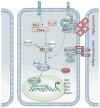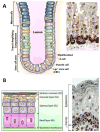The Hippo signaling pathway and stem cell biology
- PMID: 22658639
- PMCID: PMC3383919
- DOI: 10.1016/j.tcb.2012.04.006
The Hippo signaling pathway and stem cell biology
Abstract
Stem cell (SC) activity fluctuates throughout an organism's lifetime to maintain homeostatic conditions in all tissues. As animals develop and age, their organs must remodel and regenerate themselves in response to environmental and physiological demands. Recently, the highly conserved Hippo signaling pathway, discovered in Drosophila melanogaster, has been implicated as a key regulator of organ size control across species. Deregulation is associated with substantial overgrowth phenotypes and eventual onset of cancer in various tissues. Importantly, emerging evidence suggests that the Hippo pathway can modulate its effects on tissue size by the direct regulation of SC proliferation and maintenance. These findings provide an attractive model for how this pathway might communicate physiological needs for growth to tissue-specific SC pools. In this review, we summarize the current and emerging data linking Hippo signaling to SC function.
Copyright © 2012 Elsevier Ltd. All rights reserved.
Figures


Similar articles
-
Loss of the Drosophila cell polarity regulator Scribbled promotes epithelial tissue overgrowth and cooperation with oncogenic Ras-Raf through impaired Hippo pathway signaling.BMC Dev Biol. 2011 Sep 29;11:57. doi: 10.1186/1471-213X-11-57. BMC Dev Biol. 2011. PMID: 21955824 Free PMC article.
-
Boundaries of Dachsous Cadherin activity modulate the Hippo signaling pathway to induce cell proliferation.Proc Natl Acad Sci U S A. 2008 Sep 30;105(39):14897-902. doi: 10.1073/pnas.0805201105. Epub 2008 Sep 22. Proc Natl Acad Sci U S A. 2008. PMID: 18809931 Free PMC article.
-
Stem cell regulation by the Hippo pathway.Biochim Biophys Acta. 2013 Feb;1830(2):2323-34. doi: 10.1016/j.bbagen.2012.07.005. Epub 2012 Jul 20. Biochim Biophys Acta. 2013. PMID: 22824335 Review.
-
The Hippo Pathway Regulates Neuroblasts and Brain Size in Drosophila melanogaster.Curr Biol. 2016 Apr 25;26(8):1034-42. doi: 10.1016/j.cub.2016.02.009. Epub 2016 Mar 17. Curr Biol. 2016. PMID: 26996505
-
Tissue growth and tumorigenesis in Drosophila: cell polarity and the Hippo pathway.Curr Opin Cell Biol. 2017 Oct;48:1-9. doi: 10.1016/j.ceb.2017.03.006. Epub 2017 Mar 29. Curr Opin Cell Biol. 2017. PMID: 28364663 Review.
Cited by
-
Intestinal stem cell response to injury: lessons from Drosophila.Cell Mol Life Sci. 2016 Sep;73(17):3337-49. doi: 10.1007/s00018-016-2235-9. Epub 2016 May 2. Cell Mol Life Sci. 2016. PMID: 27137186 Free PMC article. Review.
-
The hippo pathway in heart development, regeneration, and diseases.Circ Res. 2015 Apr 10;116(8):1431-47. doi: 10.1161/CIRCRESAHA.116.303311. Circ Res. 2015. PMID: 25858067 Free PMC article. Review.
-
Cell adhesion molecule KIRREL1 is a feedback regulator of Hippo signaling recruiting SAV1 to cell-cell contact sites.Nat Commun. 2022 Feb 17;13(1):930. doi: 10.1038/s41467-022-28567-3. Nat Commun. 2022. PMID: 35177623 Free PMC article.
-
Gene regulatory network reconfiguration in direct lineage reprogramming.Stem Cell Reports. 2023 Jan 10;18(1):97-112. doi: 10.1016/j.stemcr.2022.11.010. Epub 2022 Dec 29. Stem Cell Reports. 2023. PMID: 36584685 Free PMC article.
-
Emerging role of Hippo pathway in the regulation of hematopoiesis.BMB Rep. 2023 Aug;56(8):417-425. doi: 10.5483/BMBRep.2023-0094. BMB Rep. 2023. PMID: 37574808 Free PMC article. Review.
References
-
- Depaepe V, et al. Ephrin signalling controls brain size by regulating apoptosis of neural progenitors. Nature. 2005;435:1244–1250. - PubMed
-
- Stanger BZ, et al. Organ size is limited by the number of embryonic progenitor cells in the pancreas but not the liver. Nature. 2007;445:886–891. - PubMed
-
- Justice RW, et al. The Drosophila tumor suppressor gene warts encodes a homolog of human myotonic dystrophy kinase and is required for the control of cell shape and proliferation. Genes Dev. 1995;9:534–546. - PubMed
-
- Xu TA, et al. Identifying tumor suppressors in genetic mosaics: the Drosophila lats gene encodes a putative protein kinase. Development. 1995;121:1053–1063. - PubMed
Publication types
MeSH terms
Substances
Grants and funding
LinkOut - more resources
Full Text Sources
Other Literature Sources
Medical
Molecular Biology Databases
Research Materials

